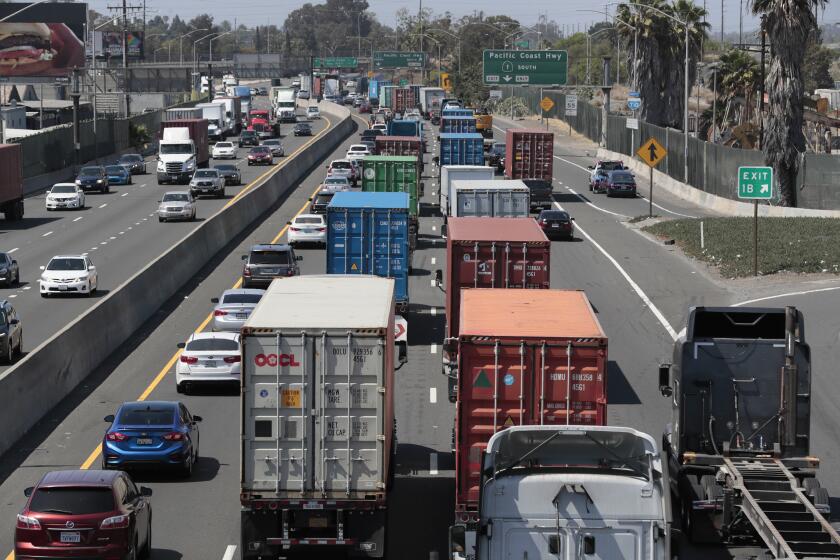EPA pollution limits aim to boost U.S. electric vehicle sales

- Share via
WASHINGTON — The Biden administration is proposing strict new automobile pollution limits that would require as many as two-thirds of new vehicles sold in the U.S. to be electric by 2032, a nearly tenfold increase over current electric vehicle sales.
The proposed regulation, announced Wednesday by the Environmental Protection Agency, would set tailpipe emissions limits for the 2027 through 2032 model years that are the strictest ever imposed — and call for far more new EV sales than the auto industry agreed to less than two years ago.
If finalized next year as expected, the plan would represent the strongest push yet toward a once almost unthinkable shift from gasoline-powered cars and trucks to battery-powered vehicles.
Here’s a look at what the EPA is proposing, how the plan serves President Biden’s ambitious goal to cut U.S. planet-warming greenhouse gas emissions in half by 2030, and whether the auto industry can meet the new EV targets.
The U.S. Environmental Protection Agency is clearing the way for California rules that will phase out the sale of diesel-powered trucks.
What is the EPA proposing?
The proposed tailpipe pollution limits don’t require a specific number of electric vehicles to be sold every year, but instead they mandate limits on greenhouse gas emissions. Depending on how automakers comply, the EPA projects that at least 60% of new passenger vehicles sold in the U.S. would be electric by 2030 and up to 67% by 2032.
For slightly larger, medium-duty trucks, the EPA projects 46% of new vehicle sales will be EVs in 2032.
EPA Administrator Michael S. Regan called the proposal “the most ambitious pollution standards ever for cars and trucks,’’ and he said it would reduce dangerous air and climate pollution and lower fuel and maintenance costs for families.
The agency will select from a range of options after a public comment period, Regan said. The rule is expected to become final next year.
What is the auto industry saying about the proposed rules?
John Bozzella, president of the Alliance for Automotive Innovation, a trade group representing most automakers, called the EPA proposal “aggressive by any measure” and wrote in a statement that it exceeds the Biden administration’s 50% electric vehicle sales target for 2030, announced less than two years ago.
Reaching half was always a “stretch goal,” contingent on manufacturing incentives and tax credits to make EVs more affordable, he wrote. It remains to be seen whether those provisions are enough to support electric vehicle sales at the level the EPA has proposed, he wrote.
“The question isn’t can this be done, it’s how fast can it be done,” Bozzella wrote. “How fast will depend almost exclusively on having the right policies and market conditions in place.”
Plenty of challenges lie ahead as California mandates zero-emission cars, including cost and access to charging.
How will the proposal benefit the environment?
The proposed standards for light-duty cars and trucks are projected to result in a 56% reduction in projected greenhouse gas emissions compared with existing standards for model year 2026, the EPA said. The proposals would improve air quality for communities across the nation, avoiding nearly 10 billion tons of carbon dioxide emissions, more than twice the total U.S. CO2 emissions last year, the EPA said.
The plan also would save thousands of dollars over the lives of the vehicles sold and reduce U.S. reliance on oil imports by approximately 20 billion barrels, the agency said.
Is the EPA proposal realistic?
With electric vehicles accounting for just 7.2% of U.S. vehicle sales in the first quarter of this year, the industry has a long way to go to even approach the Biden administration’s targets. However, the percentage of EV sales is growing. Last year it was 5.8% of new vehicle sales.
Many auto industry analysts say it will be difficult for automakers to meet the projected sales percentage. The consulting firm LMC Automotive, for instance, said new EV sales could reach 49% in 2032 but are unlikely to go above that, citing high prices for EVs compared with gas-powered cars.
A new poll released Tuesday shows that many Americans aren’t yet sold on going electric for their next cars, with high prices and too few charging stations the main deterrents. Only 19% of U.S. adults say it’s “very” or “extremely” likely they will purchase an EV the next time they buy a car, while 22% say it’s somewhat likely. About half — 47% — say they are unlikely to go electric, according to the poll by the Associated Press-NORC Center for Public Affairs Research and the Energy Policy Institute at the University of Chicago.
White House climate advisor Ali Zaidi said EV sales have tripled since Biden took office and the number of available EV models has doubled. Analysts have repeatedly revised their forecasts upward since Biden took office, and the industry announced more than $100 billion in EV investments, Zaidi told reporters Tuesday.
“The automakers have ... technology and the infrastructure and supply chain to be able to achieve this with the lead time they’ve got,” Zaidi said.
Buying and installing an electric car home charger isn’t always easy.
Why is the tailpipe rule so important?
Transportation is the largest source of carbon emissions in the U.S., accounting for about 27% of greenhouse gas emissions in 2020, according to the EPA. Electric power generates the second-largest share of greenhouse gas emissions at 25%.
Environmental groups say stricter tailpipe pollution standards are needed to clean the air and slow the effects of severe weather events such as hurricanes, tornadoes and wildfires.
“Done right, these [new rules] will put the U.S. on the path to end pollution from vehicle tailpipes — while also slashing our dependence on oil, creating good domestic jobs and saving consumers money on fuel,” said Manish Bapna, president of the Natural Resources Defense Council.
What else is the Biden administration doing to promote EVs?
Besides stricter pollution rules, tax credits for EV manufacturing and purchases included in the sweeping Inflation Reduction Act passed last year will help reach the tougher requirements, the White House and its allies said.
At present, many new EVs manufactured in North America are eligible for a $7,500 tax credit, while used EVs can get up to $4,000. However, there are price and purchaser income limits that make some vehicles ineligible. And starting April 18, new requirements by the Treasury Department will result in fewer new electric vehicles qualifying for the full $7,500 federal tax credit.
A smaller credit may not be enough to attract new buyers for EVs, which now cost an average of $58,600, according to Kelley Blue Book.
More to Read
Sign up for Essential California
The most important California stories and recommendations in your inbox every morning.
You may occasionally receive promotional content from the Los Angeles Times.













